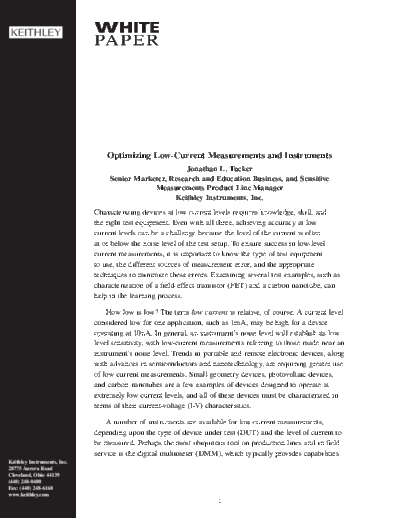Service Manuals, User Guides, Schematic Diagrams or docs for : Keithley Appnotes OptimizingLowCurrent_WP
<< Back | HomeMost service manuals and schematics are PDF files, so You will need Adobre Acrobat Reader to view : Acrobat Download Some of the files are DjVu format. Readers and resources available here : DjVu Resources
For the compressed files, most common are zip and rar. Please, extract files with Your favorite compression software ( WinZip, WinRAR ... ) before viewing. If a document has multiple parts, You should download all, before extracting.
Good luck. Repair on Your own risk. Make sure You know what You are doing.
Image preview - the first page of the document

>> Download OptimizingLowCurrent_WP documenatation <<
Text preview - extract from the document
Optimizing Low-Current Measurements and Instruments
Jonathan L. Tucker
Senior Marketer, Research and Education Business, and Sensitive
Measurements Product Line Manager
Keithley Instruments, Inc.
Characterizing devices at low current levels requires knowledge, skill, and
the right test equipment. Even with all three, achieving accuracy at low
current levels can be a challenge because the level of the current is often
at or below the noise level of the test setup. To ensure success in low-level
current measurements, it is important to know the type of test equipment
to use, the different sources of measurement error, and the appropriate
techniques to minimize these errors. Examining several test examples, such as
characterization of a field-effect transistor (FET) and a carbon nanotube, can
help in the learning process.
How low is low? The term low current is relative, of course. A current level
considered low for one application, such as 1mA, may be high for a device
operating at 10nA. In general, an instrument's noise level will establish its low-
level sensitivity, with low-current measurements referring to those made near an
instrument's noise level. Trends in portable and remote electronic devices, along
with advances in semiconductors and nanotechnology, are requiring greater use
of low-current measurements. Small-geometry devices, photovoltaic devices,
and carbon nanotubes are a few examples of devices designed to operate at
extremely low current levels, and all of these devices must be characterized in
terms of their current-voltage (I-V) characteristics.
A number of instruments are available for low-current measurements,
depending upon the type of device under test (DUT) and the level of current to
be measured. Perhaps the most ubiquitous tool on production lines and in field
service is the digital multimeter (DMM), which typically provides capabilities
Keithley Instruments, Inc.
28775 Aurora Road
Cleveland, Ohio 44139
(440) 248-0400
Fax: (440) 248-6168
www.keithley.com
1
for measuring current, voltage, resistance, and temperature. The range of commercial products
is wide, from low-cost units with 3◦ Jabse Service Manual Search 2024 ◦ Jabse Pravopis ◦ onTap.bg ◦ Other service manual resources online : Fixya ◦ eServiceinfo